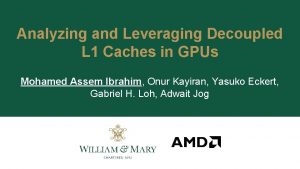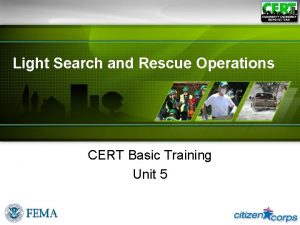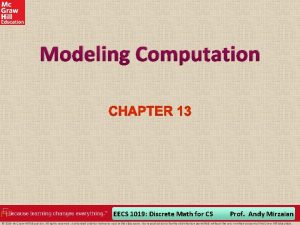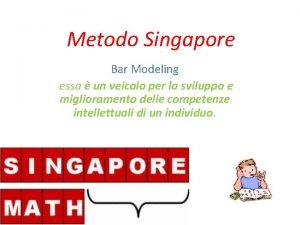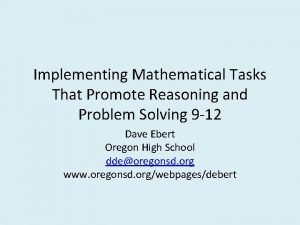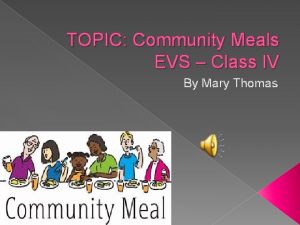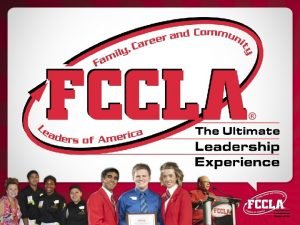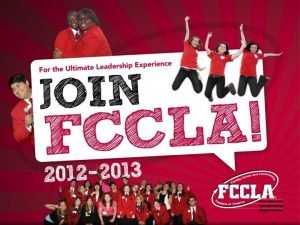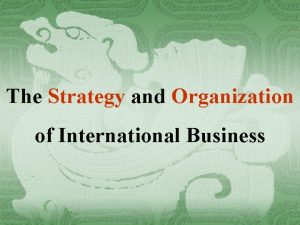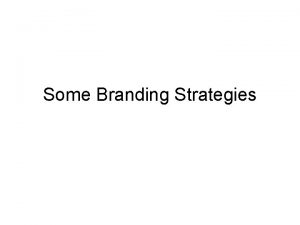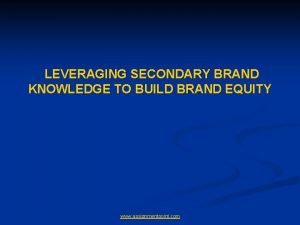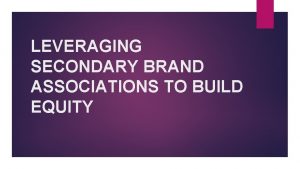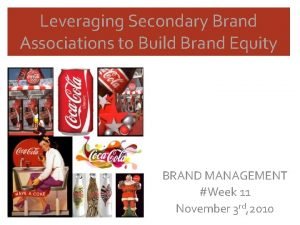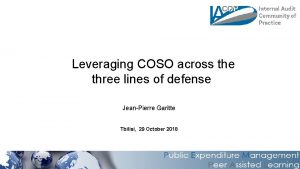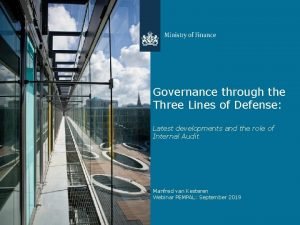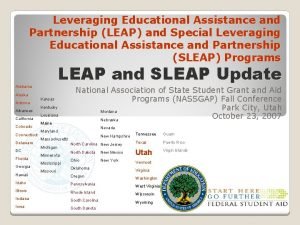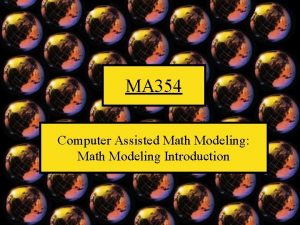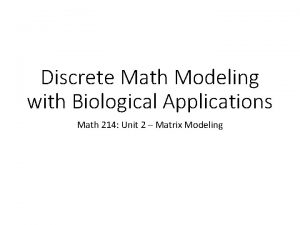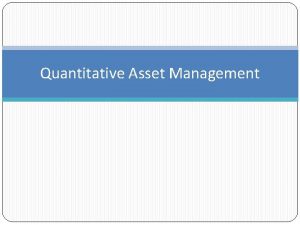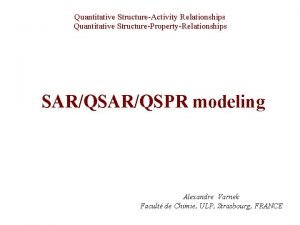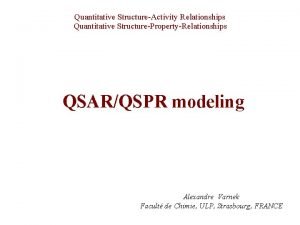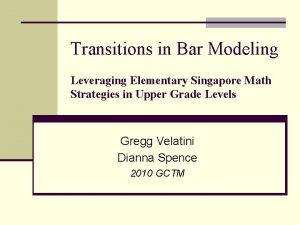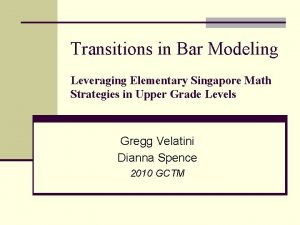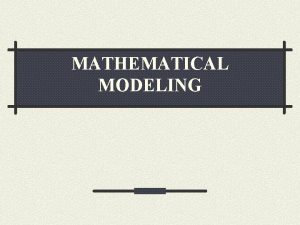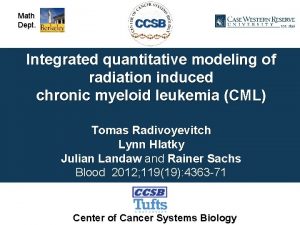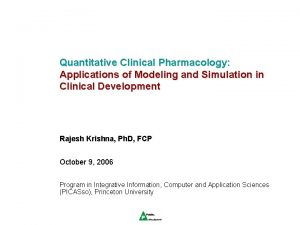Leveraging Math Modeling and Applications to Promote Quantitative



















- Slides: 19

Leveraging Math Modeling and Applications to Promote Quantitative Literacy Mark Freed Mathematics Education Specialist Oregon Department of Education OREGON RESPONSE TO INSTRUCTION AND INTERVENTION (ORTIi) 2016 Annual Spring Conference Eugene, OR April 29, 2016

The Math Challenge • College Ready? – 60% of entering community college students enroll in developmental math courses 1 – Most students (70% at CC’s) identified as unready for a credit-bearing math course will never graduate • More math courses? – Enrollment in Pre-Calculus and Calculus has doubled since 1990, – Yet one in six (17%) of students who successfully completed high school Calculus enrolled in remedial math in college 2 1 Silva, E. & White, T. (2013). Pathways to Improvement: Using Psychological Strategies to Help College Students Master Developmental Math. Carnegie Foundation. Stanford, California. http: //www. achievingthedream. org/sites/default/files/resources/Pathways. To. Improvement_0. pdf 2 Background to the MAA/NCTM Statement on Calculus, http: //www. nctm. org/uploaded. Files/Standards_and_Positions/Position_Statements/MAA_NCTM_background. pdf

Math for All? • Mathematics and statistics courses function as gateways to many majors are crucial for preparing scientifically literate citizens. Yet: – In 2012: 19. 9% of all bachelor's degrees were awarded to underrepresented minority (URM) students (9. 5% to Blacks, 9. 8% to Hispanics). – But only 11. 6% of math bachelor's degrees were awarded to URM students (4. 9% to Blacks, 6. 4% to Hispanics). – Failure rates under traditional lecture are 55% higher than for more active approaches to instruction • Lee Stiff and William Harvey (1988) noted that: “mathematics classrooms are one of the most segregated places in the United States” Stiff, L. V. , & Harvey, W. B. (1988). On the education of black children in mathematics. Journal of Black Studies, 19(2), 190 -203.

What is Math? MATH ≠ COMPUTATION >> COMPUTATION Math Computation

Democratization of Math When all aspects of mathematics are encouraged, rather than procedure execution alone, many more students contribute and feel valued…I refer to this broadening and opening of the mathematics taught in classrooms as mathematical democratization. When we open mathematics we also open the doors of math achievement and many more students succeed. ” Jo Boaler (2013). The Stereotypes That Distort How Americans Teach and Learn Math. http: //www. theatlantic. com/education/archive/2013/11/the-stereotypes-that-distort-how-americans-teach-and-learn-math/281303/ “Mathematics needs to become more accessible if it is to fulfill both its cultural and economic roles. Accessibility requires curricula to move beyond coverage of discrete operations to a deeper and more applied understanding. ” Mathematical Association of America (MAA). Quantitative Literacy: Why Numeracy Matters for Schools and Colleges. http: //www. maa. org/sites/default/files/pdf/QL/Why. Numeracy. Matters. pdf “Access and equity in mathematics at the school and classroom levels rest on beliefs and practices that empower all students to participate meaningfully in learning mathematics” National Council of Teachers of Mathematics (NCTM). Principles to Actions: Ensuring Mathematical Success for All. http: //www. nctm. org/Pt. A/

Is there one target for everyone? • Calculus is not the capstone MAA/NCTM Joint Position Statement of the Mathematical Association of America (MAA) and the National Council of Teachers of Mathematics (NCTM) on Teaching Calculus. http: //www. maa. org/programs/faculty-and-departments/curriculum-department-guidelinesrecommendations/joint-statement-teaching-calculus • And neither is College Algebra (at least how it is commonly taught today) Saxe, K. & Braddy, L. (2015). A Common Vision for Undergraduate Mathematical Sciences Programs in 2025. A joint position paper by AMATYC, AMS, ASA, MAA, and SIAM. http: //www. maa. org/sites/default/files/pdf/Common. Vision. Final. pdf

What is the target? • Quantitative Literacy (Numeracy) is key Quantitative literacy (QL), the ability to understand use numbers and data analyses in everyday life. Mathematical Association of America (MAA). Quantitative Literacy: Why Numeracy Matters for Schools and Colleges. http: //www. maa. org/sites/default/files/pdf/QL/Why. Numeracy. Matters. pdf Reading Literacy Learn to Read to Learn Numeracy Learn to “Do Math” to Learn

What is a successful student in math? The Mathematical Practices paint a picture of what student success looks like in a math classroom 1. Make sense of problems and persevere in solving them. 5. Use appropriate tools strategically. 2. Reason abstractly and quantitatively. 6. Attend to precision. 3. Construct viable arguments and critique the reasoning of others. 7. Look for and make use of structure. 4. Model with mathematics. 8. Look for and express regularity in repeated reasoning.

What is a successful student in math? The Mathematical Practices paint a picture of what student success looks like in a math classroom 1. Make sense of problems and persevere in solving them. 5. Use appropriate tools strategically. 2. Reason abstractly and quantitatively. 6. Attend to precision. 3. Construct viable arguments and critique the reasoning of others. 7. Look for and make use of structure. 4. Model with mathematics. 8. Look for and express regularity in repeated reasoning. Conjecture: Mathematical Modeling and appropriate use of tools are of particular importance in empowering all students to participate meaningfully in learning mathematics

What could Student Success Look Like? http: //www. edutopia. org/practice/performance-based-assessment-making-math-relevant In Hampton High's Disaster Relief Mission, math students role-play air traffic controllers and pilots to assess their skills in a performance-based simulation.

Discussion What practices do you see evidence of with students in the classroom you just saw? 1. Make sense of problems and persevere in solving them. 5. Use appropriate tools strategically. 2. Reason abstractly and quantitatively. 6. Attend to precision. 3. Construct viable arguments and critique the reasoning of others. 7. Look for and make use of structure. 4. Model with mathematics. 8. Look for and express regularity in repeated reasoning.

Why Modeling? 1. What does “Modeling” mean to you? 2. What do you think “Modeling” means to a mathematician?

Why Modeling? Math is: 1. 2. 3. 4. Posing the right questions Real world → math formulation Computation Math formulation → real world, verification Conrad Wolfram: Teaching kids real math with computers http: //www. ted. com/talks/conrad_wolfram_teaching_kids_real_math_with_computers? language=en

Why Modeling? ↔ h t Ma ling! e Modeling Cycle (CCSSM): Math is: 1. 2. 3. 4. Posing the right questions Real world → math formulation Computation Math formulation → real world, verification

Why Modeling & Tools? Math (Modeling) is: Students Use appropriate tools strategically. Students 1. 2. 3. 4. Posing the right questions Real world → math formulation Computation Math formulation → real world, verification

Modeling Activity • Central Park • https: //teacher. desmos. com/

Reflection Numeracy Learn to “do Math” Learn to Model 1. 2. 3. 4. “Do Math” to Learn Model to Learn Math (Modeling) is: Posing the right questions Real world → math formulation Computation Math formulation → real world, verification 1. How does the Central Park Activity give students an opportunity to: • Engage in Mathematical Modeling? • Use Tools Strategically? • Develop Numeracy?

Reflection Numeracy Learn to “Do Math” Learn to Model 1. 2. 3. 4. “Do Math” to Learn Model to Learn Math (Modeling) is: Posing the right questions Real world → math formulation Computation Math formulation → real world, verification 1. How do you see Modeling and Appropriate use of Tools helping to empower all students to participate meaningfully in learning mathematics? 2. What else do you see as needed to bring more students into meaningful math?

Questions? Mark Freed Math Education Specialist Oregon Department of Education mark. freed@state. or. us
 Helen c. erickson
Helen c. erickson Relational modeling vs dimensional modeling
Relational modeling vs dimensional modeling Analyzing and leveraging decoupled l1 caches in gpus
Analyzing and leveraging decoupled l1 caches in gpus Usar search markings
Usar search markings Modeling computation discrete math
Modeling computation discrete math Matematica metodo singapore
Matematica metodo singapore Implement tasks that promote reasoning and problem solving
Implement tasks that promote reasoning and problem solving What is community meal
What is community meal To promote personal growth and leadership fccla
To promote personal growth and leadership fccla The three r's in membership fccla
The three r's in membership fccla Protect, promote, and improve the health of all people
Protect, promote, and improve the health of all people Multidomestic strategy pros and cons
Multidomestic strategy pros and cons Brand extension vs line extension
Brand extension vs line extension Leveraging social media for talent acquisition
Leveraging social media for talent acquisition Secondary brand knowledge
Secondary brand knowledge Secondary brand associations
Secondary brand associations Leveraging secondary brand associations examples
Leveraging secondary brand associations examples Leveraging coso across the three lines of defense
Leveraging coso across the three lines of defense Leveraging coso across the three lines of defense
Leveraging coso across the three lines of defense Leveraging educational assistance partnership
Leveraging educational assistance partnership


